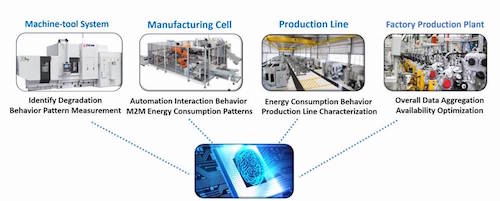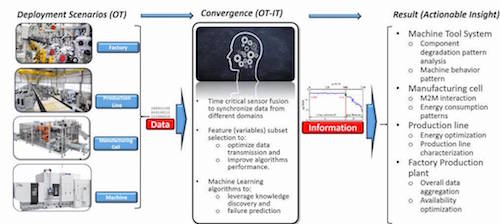Industrial Internet Consortium (IIC) Testbed Advances Smart Factory Predictive Maintenance

The goal of the Smart Factory Machine Learning for Predictive Maintenance Testbed is to achieve 100% asset availability and production line uptime. Image Courtesy of the Industrial Internet Consortium.
Latest News
October 26, 2017
Predictive maintenance, one of the most widely hyped Internet of Things (IoT) use cases, is getting a boost thanks to a testbed conducted by the Industrial Internet Consortium (IIC) and its partners, which aims to advance availability and uptime for high-volume manufacturing.
The Smart Factory Machine Learning for Predictive Maintenance Testbed is being led by Plethora IIoT, a division of ETXE-TAR focused on Industry 4.0 solutions, and Xilinx, a semiconductor provider. The testbed will explore the application of machine learning techniques on predictive maintenance problems for high-volume production machinery. The goal: To increase uptime, improve energy efficiency, and detect system anomalies prior to failure.
 The IIC test bed explores a range of IIoT-enabled predictive maintenance applications for smart factories. Image Courtesy of the Industrial Internet Consortium
The IIC test bed explores a range of IIoT-enabled predictive maintenance applications for smart factories. Image Courtesy of the Industrial Internet Consortium“The goal is no unplanned downtime,” says Dan Issacs, director of corporate strategy and market development for Xilinx.
Machine Learning and Advance Analytics
Key to the testbed’s charter is exploring the role of machine learning and advanced analytics in advancing predictive maintenance applications, specifically on the factory floor. Operating at both the machine and process level, advanced analytics will help identify system degradation before system failure, which will enable manufacturing lines and factories to operate as efficiently as possible, reducing overall operating expenses and capital equipment costs, Issacs says. Given that downtime costs can run some manufacturers as much as $22,000 per minute, the ability to pinpoint and ward off unexpected failures can have a positive impact on machine availability while increasing productivity, he explains.
 The goal of the Smart Factory Machine Learning for Predictive Maintenance Testbed is to achieve 100% asset availability and production line uptime. Image Courtesy of the Industrial Internet Consortium.
The goal of the Smart Factory Machine Learning for Predictive Maintenance Testbed is to achieve 100% asset availability and production line uptime. Image Courtesy of the Industrial Internet Consortium.There are both mathematical and thermal imaging components to the machine learning and advanced analytics exploration as part of the testbed. “In the first phase, the primary focus will be on probability and mathematical information (things like whether temperature or vibrations stay within the normal sequence) while the second phase will add thermal imaging, which will be another key layer in hunting out anomalies, Issac says.
Industry 4.0 Challenges
The Smart Factory Machine Learning for Predictive Maintenance Testbed operates like other IIC testbeds, as a highly-structured process with clear milestones that need to be met. This testbed came out of customer requirements for ETXE-TAR Group, a Spanish manufacturer of industrial equipment, including large CNC machines used to build automotive power trains. Plethora IIoT was spun out of EXTE-TAR to focus on this and other industry 4.0 challenges, according to Javier Diaz, IIoT Team Leader for Plethora IIoT.
The resulting testbed has three phases:
- Lab development and testing where the team will simulate data and fault conditions using ETXE-TAR CNC manufacturing equipment;
- field test deployment of the machine learning capabilities in a controlled facility with limited production; and
- deployment of the real-time analytics and machine learning on production machines on-site at an automotive OEM facility.
Each phase of the testbed will require the partners to share deliverables such as studies and white papers with the IIC to publicly showcase the results.
The testbed will also establish an adaptable framework, that goes from the edge to the cloud, and which can be extended to other factories or use cases—for example, a smart grid predictive maintenance application, which would require different sensors and algorithms, or a windfarm, to keep turbines on line and to optimize power generation.
Down the line, Issacs also sees information from predictive maintenance applications being fed to engineering, closing the loop to inform subsequent designs of factory equipment. “The learning we’ll get from predictive maintenance can illustrate that this particular sequence of events or part led to this failure,” he explains. “There’s a lot of data now that gives you insight, not only into the level of what’s happening at the time of failure, but that can be leveraged back into the model for subsequent design changes.”
Watch this video to learn more about how the IIC uses testbeds to drive innovation and accelerate adoption of IIoT.
Subscribe to our FREE magazine, FREE email newsletters or both!
Latest News
About the Author
Beth Stackpole is a contributing editor to Digital Engineering. Send e-mail about this article to [email protected].
Follow DE





